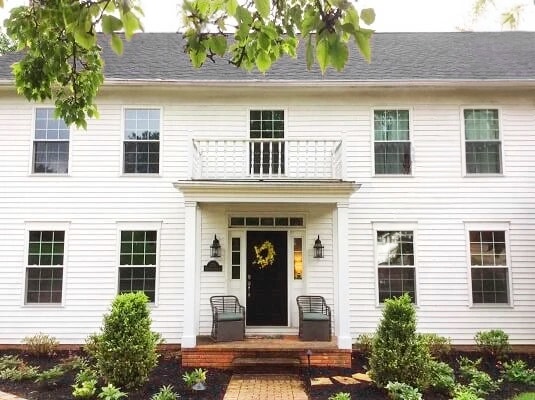Preserving the Past: Historic Window Replacement
When replacing the historic windows in your home, find out how you can preserve historical charm while still integrating modern innovations.

KEY TAKEAWAYS
- Historic window replacement balances preserving architectural integrity with modern energy-efficient upgrades.
- Custom-made windows often replicate original features, complying with preservation guidelines and enhancing authenticity.
- Window replacement offers improved performance, energy savings, and innovative features like Integrated Rolscreen® while maintaining historic charm.
Historic buildings hold cultural significance and unique charm, with architecture reflecting the craftsmanship, style and era in which they were built. A vital element of these structures is their windows, which not only provide natural light and ventilation but also contribute to the home’s character. However, as time and the elements take their toll, historic windows may deteriorate and lose their functionality. In such cases, replacing or restoring the windows becomes a necessity, but it's a project that must be approached with care and respect to preserve the home’s heritage.
Window Restoration vs. Replacement
Before starting a historic window replacement project, it's essential to assess the condition of the existing windows. Common signs that windows need to be replaced include rot, decay, warped frames and inefficient single-pane glass. In other situations, it might be better to restore the windows to their original condition, improving the existing look and performance, rather than completely replacing them. Window restoration can involve a variety of different components, such as:
- Stripping, sanding and repainting the sashes
- Repairing rotten or weak wood
- Replacing damaged glass
- Inserting new grilles or muntins
- Replacing broken parts
If you’re not sure which option is best for your project, talk to an experienced Pella expert who can help determine if replacement is necessary or if restoration is a viable option.
Navigating Preservation Guidelines and Grants
If you choose to replace your windows, be aware that in some designated historic districts local regulations may apply. Guidelines often require that replacement windows closely match the original in terms of materials, design and dimensions. Historic window replacement is a specialized process that usually requires collaboration between preservationists, architects, contractors and the window manufacturer. That’s why it’s so important to select a window manufacturer that is well-versed in historic projects. We offer authentic products that are approved by historic societies, and we work directly with each city’s historic commission to ensure compliance. For instance, Pella® Reserve™ – Traditional products have been reviewed and approved on a case-by-case basis by the National Park Service for use on projects with historic tax credits. The last thing you want is a project held up by the approval and permitting process, or even worse a fine for making unsanctioned changes.
Some cities offer various grants and historic preservation tax incentives to encourage preservation efforts, like window replacement. Research available programs in your area to help offset the cost of your project.


Custom-Made Windows
Custom windows are often necessary to replicate the unique features of historic windows. Pella’s experts are skilled in matching the historical elements of windows, including:
- Window frame, size and shape
- Glass size and divisions
- Sash size
- Finishes
- Glass characteristics
- Grilles and glazing
- Shutters and blinds
Selecting the right material is essential for achieving an authentic look and ensuring longevity. Pella Reserve wood windows are a popular choice for historic window replacement due to their traditional appeal and ability to be customized. These windows are known for their unparalleled historical detailing and authentic hardware.
Benefits of Replacing Historic Windows
Preserving historic charm doesn't mean sacrificing energy efficiency. A primary benefit of window replacement is that you can recreate the original look while incorporating modern technology and innovations. For instance, replacement windows can feature larger panes of glass with grilles, rather than small individual panes that are less efficient. Replacement windows can also include insulated triple-pane glass which can improve energy efficiency, helping homeowners save on utility costs. Pella’s Integrated Rolscreen® innovation allows homeowners to enjoy screens when their windows are open but maintain the historic screenless look when closed. The screen rolls away out of sight when it’s not being used. Single-hung and double-hung windows, which are popular in historic homes, have sashes that tilt in for easy cleaning from inside the house. These modern technologies, among others, improve performance and functionality while maintaining the architectural integrity of the home.

Historic window replacement is a delicate balance between preserving the past and embracing modern technology. By respecting the unique qualities of historic windows and selecting energy-efficient features, homeowners can honor the history of their home while enjoying high-performing, innovative windows that are built to last.

